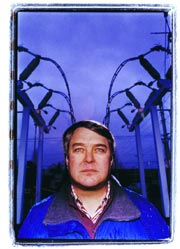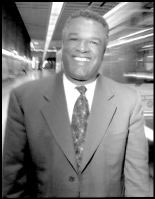Should he stay or should he go? The man in question is Seattle City Light Superintendent Gary Zarker, who last week began a tough reconfirmation process before the Seattle City Council. On the face of it, the question might seem laughably simple. Zarker ran up City Light’s credit card to the tune of $600 million during the energy crisis of 2000-2001, bringing the utility’s debt load to a staggering $1.6 billion—the largest ever. Standard & Poor’s, the financial world’s Solomon, responded by downgrading City Light’s credit rating three times in a 22-month period.
In order to pay off this debt, rates have been raised 58 percent in the past three years. During the same period, City Light struggled with billing problems, overcharging residential customers by thousands of dollars, and compounded that by refusing, at first, to acknowledge the mistakes.
The venerable Municipal League of King County has expressed “no confidence in the current Seattle City Light senior management.” The Muni League’s energy chair, Bruce Carter, asks pointedly: “If [Zarker] was working for Puget Sound Energy,” a private utility, “where would he be?”
Zarker has his defenders, however. The most important one is Mayor Greg Nickels, who “proudly” sent Zarker’s name to the City Council for reconfirmation last week. “At the end of the day, [Zarker] has done a good job,” says Nickels. “I consider him a friend and an outstanding public servant.”
Numerous solons within the energy industry also support Zarker, believing his strengths outweigh his weaknesses.
Zarker himself makes a strong case for his leadership, demonstrating an encyclopedic knowledge of both Seattle City Light and the issues facing the electrical industry in the 21st century. He contends that the majority of City Light’s problems stem from the utility being the victim of the “unparalleled corporate swindle” perpetrated by corrupt energy traders like Enron.
The debate over Zarker over the next six weeks will culminate in a vote by the City Council on March 10. “It’s not the first time I’ve been scarred up,” says Zarker bemusedly. “I’ve been around City Hall long enough that I know the interest in departments waxes and wanes. [Now] it’s City Light’s turn. You make the best of that while the light is shining on you.”
SEATTLE’S ‘CROWN JEWEL’
Seattle City Light is one of the metropolitan area’s most important institutions. It became a full-fledged city department in 1910 and has grown to serve about 680,000 people in a 131-square-mile area from Seattle to Lake Forest Park and Shoreline to the north, and Burien and Tukwila to the south. It employs 1,700 people, has an annual budget of more than $900 million, and is the nation’s seventh-largest publicly owned electric utility.
City Light generates 45 percent of its power from dams it owns in Washington state. Long-term contracts, which also primarily involve hydroelectric generation, make up another 46 percent of the utility’s portfolio. Rounding out City Light’s energy resources are contracts for wind power (3 percent) and power generated by gas-fired turbines (6 percent). Since hydroelectricity is relatively low cost—”the fuel is free,” Zarker quips—City Light has been able to provide rates that compare very favorably. Even after all of the utility’s problems in recent years, Seattle still has the cheapest electricity among the nation’s 25 largest cities.
Zarker’s critics prefer to use other local utilities to measure City Light’s performance. The Muni League says Tacoma Power, that city’s public utility, has lower rates, even though it faced the same challenges.
A TOUGH, BRAINY VETERAN
“Don’t jump,” Zarker jests as he catches me admiring the sweeping view of downtown and Elliott Bay from his office window 32 stories high in the city-owned Key Tower. If Zarker ever considered leaping himself during the energy crisis of 2000-2001, he wouldn’t let on. Zarker is a tough, brainy survivor who has spent 24 of his 54 years on the planet as an employee of Seattle city government.
In 1979, at age 30, he joined Mayor Charles Royer’s Office of Management and Budget. Four years later, he was heading the department. He went on to direct the Seattle Engineering Department for eight years under both Royer and Norm Rice. At the time, the Engineering Department oversaw solid waste, sewage, and transportation. He was in the middle of the huge debate over whether to build a municipal incinerator or institute one of the nation’s first comprehensive curbside recycling programs.
In 1994, Rice tapped Zarker to take over City Light. The utility had been hit with a heap of lawsuits over discrimination on the basis of gender and race and over sexual harassment. Zarker made headway on internal cultural issues. Moreover, as a veteran of many City Hall wars and regime changes, he has proven adept at the political part of the superintendent’s job. He receives high marks from a variety of observers in a number of other key areas: conservation, alternative energy, providing for low-income customers, making the dams fish-friendly, and leadership on regional and national energy issues. From a public relations point of view, for six years Zarker kept City Light out of the headlines.
The energy crisis of 2000-2001 changed all that.
NO SHELTER FROM THE STORM
All sides in the debate over Zarker’s tenure admit that corrupt energy traders manipulated the energy market during 2000-2001, driving prices that had been as low as $20 per megawatt hour to as high as $3,000 per megawatt hour. The debate centers on City Light’s response to the crisis.
Zarker and his allies see the utility as a victim of a terrible crime. Any suggestion that they may have contributed to the problem is met with a response similar to a sexual-assault survivor being told her skirt was too short: Don’t blame the victim.
The Muni League and Zarker’s critics see the situation as analogous to losing your house in a card game. First of all, City Light was foolish to get into the game, since it’s well known the utility can’t play cards. Secondly, even if the game was fixed, why didn’t they pull out instead of betting the farm? Four related factors came together during the energy crisis that required the purchase of $600 million’s worth of energy on City Light’s credit card: drought, market manipulation, market exposure, and risk management. The increased debt resulted in skyrocketing rates.
- Drought: The 2000-2001 drought meant City Light had less power than expected and therefore had to buy more energy on the market. While nature played the dominant role, Seattle’s politicians contributed, as well, by consistently directing City Light to keep its rates low, even in drought conditions, as far back as the 1980s. Critics argue that Zarker should have challenged the wisdom of such an approach.
- Market manipulation: Energy traders used deregulation to carry out a variety of scams to force prices to unprecedented levels. To illustrate the power of manipulation, Zarker points to City Light’s performance during the current drought. This year, in the absence of market manipulation, the utility is on track for a $100 million surplus. Zarker’s critics say Tacoma Power handled the market manipulation better than Seattle City Light.
- Market Exposure: During 2000-2001, Seattle City Light bought more power on the open market than ever before. Many observers and City Light agree that playing the market this way was an industry-wide phenomenon. Many utility executives believed that market prices would be kept low by plentiful energy supplies from new independent power producers. In the years before market manipulation and the drought, the Muni League estimates, City Light unwisely raised the amount of energy purchased on the open market from 5 percent of its total needs to 13 percent by terminating long-term contracts and selling its share of a coal plant.
- Risk management: Traditionally, City Light operated in a complex universe where rainfall, mountain snowpack, the energy usage of hundreds of thousands of homes and businesses, and the price of long-term and short-term contracts all made the best way forward very difficult to discern. In the mid-1990s, City Light added to these complications with those increasing power purchases from the open market. That world is risky, much like other commodity markets.
In 1997, the Muni League says, City Light dismantled its Energy Resources Planning and Forecasting Group. Says the Muni League’s Carter: “City Light seemed to abandon analysis and planning just before they got into these big decisions.”
Jake Fey, a veteran energy executive who sits on the board of Tacoma Power, doesn’t believe any amount of analysis would have mitigated the shenanigans of the energy crooks. “How could anyone have possibly predicted that?” he asks. Surprisingly, Fey says, the superior performance by Tacoma Power had more to do with “judgment and luck” than any trenchant internal analysis by the utility.
In 1998, City Light added a new power-marketing group that carries out trading on the energy market. City Light critics have roundly criticized the performance of this group. In addition, the Muni League and others point out that City Light lacked a set of policies that would carefully guide the activity of the traders, including directives on minimizing risk and limiting losses.
Zarker defends the traders’ performance while acknowledging the past inadequacy of the utility’s risk management. He claims, however, that City Light has changed the ways it manages risk and is going to do more.
Clearly the overall record here is muddy. Assigning blame for City Light’s performance during the energy crisis is just as complex as the crisis itself.
GOOD WEATHER AHEAD?
Seattle City Council Energy Chair Heidi Wills is upbeat about the current state of City Light. After the energy crisis, City Light and the council developed a new strategy: The utility no longer relies on the open market for its power needs.
City Light now can meet all of its customers’ energy needs through its own dams and long-term contracts, including major purchases in wind power and energy from gas-fired turbines. This aggressive purchasing means that City Light now has energy to sell on the market. Last year, City Light’s energy traders made $100 million on the energy market. That money is going to pay down some of the debt incurred by the utility during the energy crisis.
This strategy does not please everyone. Kirvil Skinnarland is a veteran energy executive who has worked for City Light and Tacoma Power. She worries that City Light’s “surplus strategy” is still too exposed to market risk. “Selling power on the wholesale market is not something that City Light has ever done before. It’s speculative.”
Zarker argues the success of the numbers speaks for itself.
The Muni League’s Carter says the wind- and gas-power purchases were too expensive. The 20-year contracts set the cost of wind and gas energy at between $50 and $60 per megawatt hour. Currently, market prices are between $20 and $40. Zarker says he believes the contracts will pencil out over the years of the contract. “If you measured investments in new generation solely on how they compared to the market in the first year, this city would not have built the Skagit [dams],” he observes tartly.
CITY COUNCIL MEMBER Wills thinks “some very important lessons were learned” by City Light. She points to changes, including the development of the new risk-management strategy, the diversification of the power portfolio, and a new planning strategy focused on meeting demand without market purchases, even in low-water years.
The Muni League does not have that confidence. Their main evidence is an extremely thorough, complex audit completed in October by Vantage Consulting for the City Council. Vantage severely criticizes City Light for 100-plus pages, citing the utility’s current risk management and strategic planning.
Vantage also points to some management problems that City Council Energy Committee members Margaret Pageler, Jim Compton, and Richard Conlin echo: City Light’s senior management has too few people with utility experience. Most of Zarker’s executive team comes from other city departments. The corporate culture at the utility is “dysfunctional”—defensive, unable to learn from mistakes, and skilled at substituting public relations for real change.
Responds Zarker: “My personal view is that our management is a good balance of utility experience and good managers. [Vantage’s] criticism was somewhat shallow in that it only looked at the top managers.” Zarker contends that below the executive team is a wealth of broad utility experience.
As for a “dysfunctional” corporate culture, Zarker believes that gets back to how you view the energy crisis. He argues that Vantage interpreted City Light’s fury over corporate crime as defensiveness. “Do we make mistakes? You bet we do. Do we learn from them? I hope so.” He adds, “I don’t want to debate the [Vantage] audit anymore. There are 33 recommendations. I think we’ve done 90 percent of them. I want to move forward.”
Most City Council members share that desire. But what about the public at large?
“People want someone’s head,” observes City Council member Nick Licata. He summarizes the conventional wisdom: Zarker “‘was in charge; rates went up; there’s a huge debt; he should fall on his sword.’ I don’t necessarily buy that, but we can’t have a go-along, get-along philosophy, either.”
LICATA SAYS THE council is in a bind. If it unfairly scapegoats Zarker, it risks doing more damage to an already wounded utility. If members reconfirm Zarker, even with good reasons, the public will believe the fix was in from the start.
After all, Zarker and Mayor Nickels have been professional friends for 25 years. The City Council, despite a great deal of bellyaching, has been loath to actually stand up to the mayor. During budget negotiations this year, the council had to struggle with a $60 million deficit. Yet when the mayor threatened the funding for a fire truck unless the council approved a $500,000 increase in the mayoral staff, the council quickly caved. Imagine what Nickels would threaten if the council got close to canning Zarker.
Council member Conlin has come up with an ingenious solution: delay a vote on confirmation. Conlin says the City Council ought to use the reconfirmation process to identify benchmarks and give Zarker a probationary period of a year to achieve the goals. “Here’s the criteria, come back in a year and we’ll take a vote.”
We’ll know on March 10 which of the paths—confirm, dismiss, or delay—the City Council will take.









